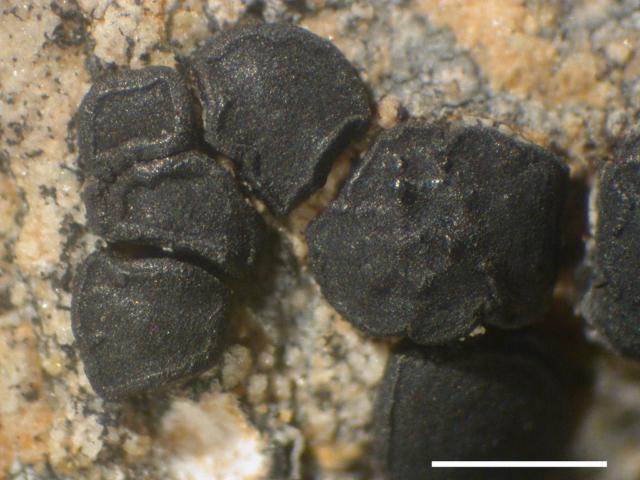
Consortium of Lichen Herbaria
- building a Global Consortium of Bryophytes and Lichens as keystones of cryptobiotic communities -
- Home
- Search
- Images
- Species Checklists
- US States: O-Z >
- US National Parks
- Central America
- South America
- US National Parks
- Southern Subpolar Region
|
Family: Ramalinaceae |
Nash, T.H., Ryan, B.D., Gries, C., Bungartz, F., (eds.) 2004. Lichen Flora of the Greater Sonoran Desert Region. Vol 2. Life habit: lichenized Thallus: endo- to episubstratic, crustose, rimose or areolate; prothallus: not discernible areoles: (if developed) continuous or dispersed, flat to slightly convex surface: white, ivory, pale gray, pale grayish brown, smooth to shiny; without soredia or isidia medulla: white, I- photobiont: primary one a trebouxioid green alga, secondary one absent Ascomata: apothecial, sessile (with an often well constricted base) or appressed, black (at least when dry), tiny (0.1-0.5 wide) to medium sized (0.6-2.5 mm in diam); true exciple: usually persistent, with a small to very broad greenish or brownish or dark brown cortex and an usually unpigmented, translucent to opaque medullary part, composed of +radiating hyphae, with or without algae; sometime the exciple becomes reduced during development; K- or (in A. pilati only) K+ red solution (7-chloroemodin) epihymenium: greenish to bright green (pigment cinereorufa-green) hymenium: colorless, or pale green, I+ blue to I+ red brown, 35-60 µm tall hypothecium: moderately thick, unpigmented to very pale yellowish brown paraphyses: simple or occasionally branched and anastomosing, apical cells usually markedly swollen; conglutinated asci: Bacidia-type, clavate, moderately thick-walled, apically thickened, outermost gelatinous layer I+ red-brown (in diluted Lugol's solution[1:6] I+ bluish), with 8 ascospores ascospores: simple to 1-septate, ellipsoid to oblong, rarely allantoid, colorless, not amyloid Coniomata: pycnidial, immersed, globular conidia: simple, colorless, bacilliform, 4-12 x 0.6-1.2 µm, acrogenously developed at short, bottle-shaped phialides Secondary metabolites: atranorin, sometimes traces of xanthones or 2'-O-methylperlatocic acid, but most often no compounds detectable with TLC Geography: Northern and Southern Hemisphere, in cool temperate to cold, preferential humid areas Substrate: on acid and (more rarely) on calcareous rocks, as well as on lignum or bark. Notes: The name Lecidea derives from the Greek adelos (= inconspicuous) and lekis (small shield; referring to the gross morphologically similar genus Lecidea). |
Powered by Symbiota









